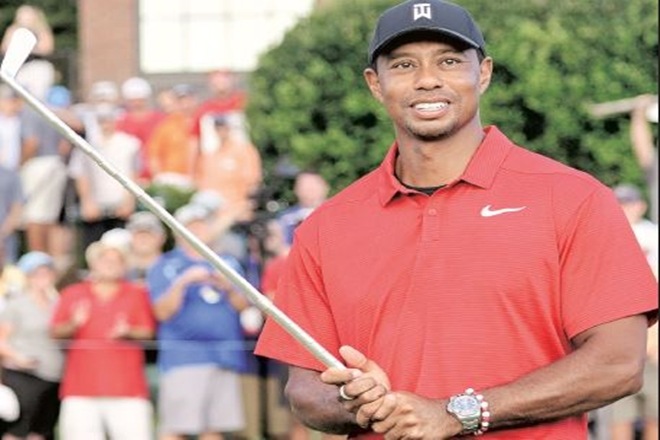Yes, he flopped at the Ryder Cup. In fact, Tiger Woods’ eighth appearance at the storied team event was a complete whitewash: he lost both singles matches and the fourballs, and the foursomes. Throughout the event, Woods looked tired, listless and demoralised, and once it was all over, he looked positively forlorn. To be fair, Woods’ Ryder Cup record in the team events is rather dismal, belying his otherwise fantastic career feats. After this Ryder Cup, Woods has made eight appearances and registered 17 wins offset by 17 losses. This was the first time, however, that he’s lost a match in the Singles. Woods admitted that his physical conditioning had not been able to cope with his schedule that saw him qualify and play all the season-ending events of the FedEx Cup. “…So a lot of big events, and a lot of focus, a lot of energy goes into it. For me, it’s been a lot of golf for a short period of time.
I’ll have a better understanding of what my training needs to be for next year so that I certainly can endure the entire season, because this year was very much up in the air of how much I would play or if I would play at all,” said a dejected-looking Woods at the post-event press conference.
Now there’s plenty of justification that exonerates Woods’ performance this time at the biennial event, but, plainly put, Woods has never been an outstanding team player. What he is, without a shred of doubt, is the player of the generation: the player who was able to worm his way into the Ryder Cup squad after an extended sabbatical during which he wasn’t even able to lift a club, let alone swing it. The fact that he played terribly is not half as significant as the fact that he played the 2018 Ryder Cup—especially as a player who made the squad of merit. Woods has gone from his world ranking of 1,199 in December 2017 to 13th in the world today.
Let’s leave the Ryder Cup be for the time being—that deserves a write-up on its own—and rewind back a fortnight to the Tour Championship. The final event on the PGA Tour’s regular season—and finale to the FedEx Cup—invites only the top 30 players on the money list to tee it up. On the back of multiple top 10 finishes, Woods had already risen to 20th in the FedEx Cup standings at the end of the regular season. He lost five spots, and then proceeded to reclaim that ranking going into the Tour Championship.
I won’t ramble about the way Woods went about winning at East Lake GC: protecting a 54-hole lead successfully on the final day (he’s never lost any event from that position). The most remarkable moment, that typifies just where Woods is when it comes to mental strength and confidence, came on the tee of the 72nd hole. Needing a par to win outright, Woods split the narrow fairway with his drive: the ball flew 348 yards before settling yards before a water hazard. Two-putts later, he’d done what was needed, and importantly, done it in a fashion that showed no fear. This was truly the Tiger Woods of yore—brimming with confidence in his game, and ability to get the job done. Sharing glory with Woods on the final hole of the event was Englishman Justin Rose who needed to close out with a birdie to win the FedEx Cup. Under immense pressure, Rose hit his longest drive of the tournament—367 yards—that was followed by a wedge and a putt to seal the deal. The difference between hitting that drive in the fairway or in the rough, works out to roughly $10 million (the winner’s cheque for the FedEx Cup). Think of that next time you’re feeling pressure in your weekend game!
Fielding questions at the tournament champion’s press conference, Woods dismissed suggestions that his was the greatest comeback in golfing history. “Ben Hogan. I mean, he got hit by a bus and came back and won major championships. The pain he had to endure, the things he had to do just to play, the wrapping of the leg, all the hot tubs, and just how hard it was for him to walk, period… One of the greatest comebacks there is and it happens to be in our sport,” said Woods, delivering a history lesson.
A short film that’s gone viral shows Woods watching a montage of clips of people—celebrities, sportsmen, talk show hosts, commentators and fans—talking, on air, about how Woods’ career is over. Kaput. Finished. In the film, Woods doesn’t say a word, only allowing himself a bit of a wry grin at some of the more extreme views expressed. The Woods of yore wouldn’t have let it go at that. The Woods who stepped on the jugular of rivals and made no bones about it.
This Woods is different. He didn’t say more because he was one of those people—those who weren’t convinced that he’d be able to play, let alone compete, again. Battling such debilitating pain that all he wanted was to be able to walk and play with his kids again. That’s life. This is just golf. And Woods knows the difference. At the tournament champion’s press conference, Woods put that into perspective: ”Just to be able to compete and play again this year, that’s a hell of a comeback.”
-A golfer, Meraj Shah also writes about the game


